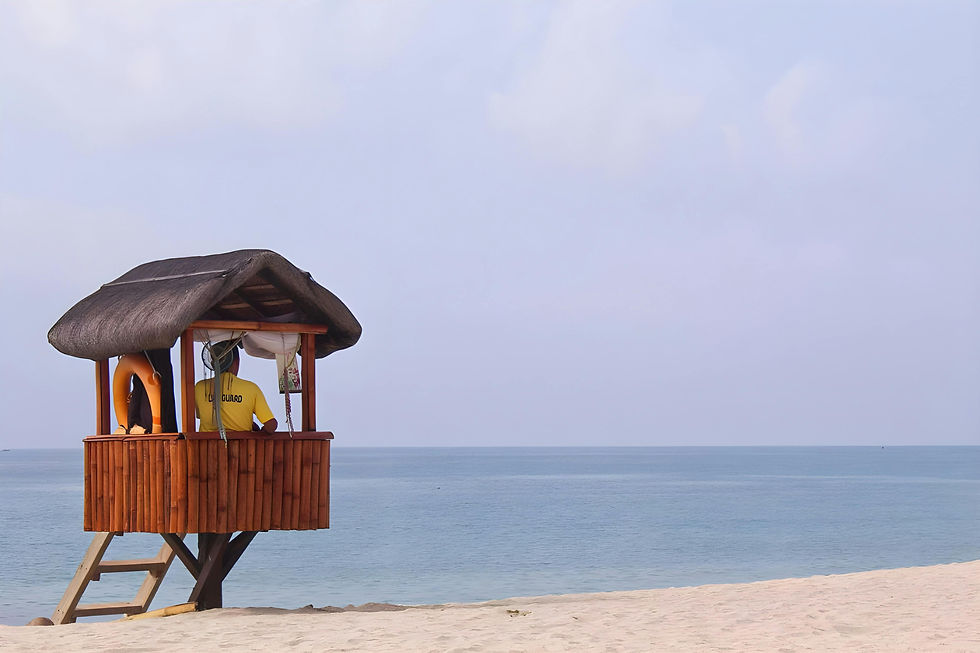The Essential Guide to Lifeguard Training
- chrisroot010
- Aug 9, 2024
- 5 min read
Lifeguard training is a vital process that equips individuals with the skills and knowledge needed to ensure safety in aquatic environments. Whether at the pool, beach, or waterpark, lifeguards play a critical role in preventing accidents and saving lives. At American Lifeguard USA, we emphasize the importance of rigorous training programs that prepare lifeguards for the challenges they may face on the job. This comprehensive guide explores the key elements of lifeguard training, why it’s essential, and how you can get started.

1. Understanding the Importance of Lifeguard Training
A Life-Saving Responsibility
Lifeguards are responsible for the safety of swimmers and beachgoers, and their role cannot be overstated. Proper training ensures that lifeguards are prepared to act swiftly and effectively in emergencies. Through a combination of theoretical knowledge and practical skills, lifeguards learn to prevent drowning, provide first aid, and perform rescues.
Why Certification Matters
Lifeguard certification is more than just a requirement; it’s a testament to a lifeguard’s ability to perform their duties effectively. At American Lifeguard USA, our certification programs are designed to meet national standards, ensuring that our lifeguards are among the best-trained professionals in the field.
2. Core Components of Lifeguard Training
Water Rescue Techniques
One of the most crucial aspects of lifeguard training is mastering water rescue techniques. These include swimming skills, rescue approaches, and the use of rescue equipment. Lifeguards are trained to handle various scenarios, from distressed swimmers to unconscious victims, ensuring they can provide the necessary assistance when it matters most.
CPR and First Aid
Cardiopulmonary resuscitation (CPR) and first aid are integral parts of lifeguard training. Lifeguards must be prepared to administer CPR in cases of cardiac arrest and provide first aid for injuries like cuts, sprains, and fractures. These skills are essential not only for the safety of swimmers but also for the overall effectiveness of the lifeguard team.
Surveillance and Prevention
Prevention is a key focus in lifeguard training. Lifeguards are trained to maintain vigilant surveillance of their designated areas, identify potential hazards, and take proactive steps to prevent accidents. This includes understanding the dynamics of water environments, recognizing signs of distress, and enforcing safety rules.
Emergency Action Plans
Lifeguard training also involves developing and implementing emergency action plans (EAPs). These plans outline the procedures that lifeguards must follow in various emergency situations, from water rescues to evacuations. At American Lifeguard USA, we emphasize the importance of clear, well-practiced EAPs to ensure a coordinated and effective response.
3. The Lifeguard Training Process
Step 1: Enrollment and Prerequisites
Before starting lifeguard training, candidates must meet specific prerequisites. These typically include a minimum age requirement, the ability to swim a certain distance, and the completion of a pre-course swimming test. American Lifeguard USA offers a range of training programs tailored to different levels of experience and expertise.
Step 2: Classroom Instruction
Theoretical knowledge is the foundation of lifeguard training. Classroom instruction covers topics such as water safety, the principles of lifeguarding, emergency response procedures, and legal responsibilities. Understanding the science behind water safety and rescue techniques is crucial for lifeguards to make informed decisions during emergencies.
Step 3: Practical Training
Practical training is where lifeguard candidates put their knowledge into action. Under the supervision of experienced instructors, trainees practice water rescues, CPR, first aid, and the use of rescue equipment. This hands-on experience is vital for building confidence and competence in real-life scenarios.
Step 4: Assessment and Certification
At the end of the training program, candidates must pass a series of assessments to earn their lifeguard certification. These assessments typically include written exams, practical skill tests, and a final water rescue simulation. American Lifeguard USA ensures that all certified lifeguards meet the highest standards of proficiency and readiness.

4. Specialized Lifeguard Training Programs
Open Water Lifeguarding
Open water lifeguarding requires additional training due to the unique challenges of natural water environments such as oceans, lakes, and rivers. Lifeguards must learn to navigate currents, tides, and varying weather conditions. American Lifeguard USA offers specialized open water lifeguard training programs that prepare lifeguards for these demanding settings.
Waterfront Lifeguarding
Waterfront lifeguarding is a specialized area that covers waterparks, waterfront resorts, and other recreational facilities with water features. This training focuses on managing crowds, operating water slides, and dealing with potential hazards specific to these environments.
Lifeguard Instructor Training
For those interested in teaching lifeguard courses, lifeguard instructor training is available. This program trains experienced lifeguards to become certified instructors, enabling them to teach and certify new lifeguards. American Lifeguard USA provides comprehensive instructor training, ensuring that the next generation of lifeguards is trained by knowledgeable and skilled professionals.
5. The Benefits of Lifeguard Training
Enhanced Safety for All
The primary benefit of lifeguard training is the enhanced safety it provides for swimmers and beachgoers. Well-trained lifeguards can prevent accidents, respond quickly to emergencies, and save lives. This level of safety is essential for maintaining public trust and ensuring that aquatic facilities operate smoothly.
Career Opportunities
Lifeguard training opens the door to various career opportunities in the aquatics industry. Certified lifeguards can work in a range of settings, from community pools to luxury resorts, and even pursue advanced roles such as lifeguard supervisors or instructors. American Lifeguard USA’s certification is widely recognized, making our graduates highly sought after by employers.
Lifelong Skills
The skills learned during lifeguard training extend beyond the job itself. Lifeguards develop valuable skills in leadership, communication, and teamwork, all of which are transferable to other areas of life. Whether pursuing a career in lifeguarding or another field, the experience gained through lifeguard training is invaluable.
6. How to Get Started with Lifeguard Training
Finding a Training Program
The first step to becoming a lifeguard is finding a reputable training program. American Lifeguard USA offers a variety of lifeguard training courses across the country, catering to different levels of experience and interest. Our programs are designed to be accessible and flexible, allowing you to find a course that fits your schedule.
Preparing for Training
Preparation is key to success in lifeguard training. Prospective lifeguards should focus on building their swimming skills, maintaining physical fitness, and familiarizing themselves with basic water safety principles. American Lifeguard USA provides resources and guidance to help you prepare for your training journey.
Enrolling in a Course
Once you’ve selected a training program, enrolling is easy. Visit the American Lifeguard USA website, choose your desired course, and complete the registration process. Our team is here to assist you every step of the way, ensuring a smooth and enjoyable training experience.
7. Summary: The Lifelong Value of Lifeguard Training
Lifeguard training is more than just a course; it’s an investment in safety, skill development, and career growth. At American Lifeguard USA, we are committed to providing top-tier training that equips lifeguards with the knowledge and abilities they need to excel. Whether you’re just starting or looking to advance your lifeguard career, our training programs offer the comprehensive education and hands-on experience required to succeed.
With American Lifeguard USA, you’re not just training to be a lifeguard; you’re preparing to be a hero in your community. Get started today and join the ranks of highly trained lifeguards who are making a difference every day.
ALSO More Read About; Why American Lifeguard USA is Your Best Choice for Training




Comments